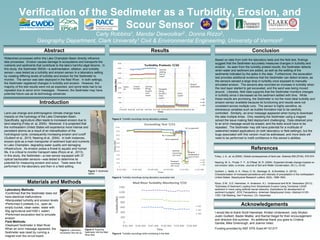
Verification of Sedimeter as Turbidity, Erosion Sensor
- 1. Verification of the Sedimeter as a Turbidity, Erosion, and Scour Sensor Carly Robbins1, Mandar Dewoolkar2 , Donna Rizzo2, Geography Department, Clark University1 Civil & Environmental Engineering, University of Vermont2 Abstract Materials and Methods Conclusion Introduction References Foley, J. A., et. al (2005). Global consequences of land use. Science,309 (5734), 570-574. Nearing, M. A., Pruski, F. F., & O'Neal, M. R. (2004). Expected climate change impacts on soil erosion rates: a review. Journal of Soil and Water Conservation, 59 (1), 43-50. Guilbert, J., Betts, A. K., Rizzo, D. M., Beckage, B., & Bomblies, A. (2015). Characterization of increased persistence and intensity of precipitation in the northeastern United States. Geophysical Research Letters, 42(6), 1888-1893. Rizzo, D.M., S.D. Hamshaw, H. Anderson, K.L. Underwood and M.M. Dewoolkar (2013), “Estimates of Sediment Loading from Streambank Erosion Using Terrestrial LIDAR sediment in rivers using artificial neural networks: Implications for development of sediment budgets”, EOS Transactions, American Geophysical Union, Abstract H13D- 1353, Fall Meeting, San Francisco, CA, December. Acknowledgements I would like to thank Scott Hamshaw, Kristen Underwood, Jody Stryker, Justin Guilbert, Baxter Miatke, and Rachel Siegel for their encouragement and direction this summer. An additional thank you goes to Cristina Gandia, Mike Greenough, and Joanne Velez. Funding provided by NSF EPS Grant #1101317. Land use change and anthropogenic climate change have impacts on the hydrology of the Lake Champlain Basin. Specifically, agriculture often leads to increased erosion due to land clearing (Foley et. al, 2005). Moreover, it is projected that the northeastern United States will experience more intense and persistent storms as a result of an intensification of the hydrological cycle, consequently increasing erosion and runoff (Guilbert et al., 2015; Nearing et al., 2004). In both instances, erosion acts as a main transporter of sediment load and nutrients to Lake Champlain, degrading water quality and damaging infrastructure. As erosion poses a threat to aquatic and human life, it is critical to monitor transport rates (Rizzo et al., 2013). In this study, the Sedimeter—a new sensor equipped with 37 optical backscatter sensors—was tested to determine its potential for measuring erosion and scour. Tests were first performed in the laboratory and then in a field setting. Results Figure 2: Laboratory excavation test set-up Laboratory Methods: •Confirmed that the Sedimeter does not have electrical malfunctions •Manipulated turbidity and erosion levels •Performed 4 pretests (i.e., open air, empty bucket, clean water, water with 50g agricultural soil/1000 L water) •Performed excavation test to simulate erosion Field Methods: •Deployed Sedimeter in Mad River When an error message appeared, the Sedimeter was reset by running a magnet over the circuit board. Figure 4: Turbidity recordings during laboratory pretests Figure 6: Turbidity recordings while monitoring in the field Figure 5: Turbidity recordings during laboratory excavation test Based on data from both the laboratory tests and the field test, findings suggest that the Sedimeter accurately measures changes in turbidity and erosion. As seen from the turbidity pretest results, the Sedimeter detects when water and sediment are added, as well as the settling of the sediments indicated by the spike in the data. Furthermore, the excavation test provides additional evidence that the Sedimeter can detect erosion, as the sensors sensed a large drop in turbidity once exposed to manually simulated erosion. The sensors also recorded an increase in turbidity when the next layer started to get excavated, and the sand was being moved around. Likewise, field data supports that the Sedimeter monitors changes in turbidity since it decreased as the sediment settled with time. While these results are promising, the Sedimeter is not the most ideal turbidity and erosion sensor available because its functioning and results were not consistent across multiple runs. The sensor is highly sensitive, so extraneous variables such as bubble formation had to be carefully controlled. Similarly, an error message appeared when trying to download the data multiple times. Only resetting the Sedimeter using a magnet solved the issue making field deployment challenging. Data obtained prior to an error message would be erased, and the tests would have to be repeated. The Sedimeter may still have potential for a multitude of watershed related applications (in both laboratory or field settings), but the bugs associated with this version must be addressed, and more tests will need to be performed to instill confidence in this sensor’s abilities. Watershed processes within the Lake Champlain Basin directly influence lake processes. Erosion causes damage to ecosystems and transports the nutrients and sediments that contribute to the lake’s harmful algal blooms. In this study, the Sedimeter SM3A—a sedimentation, siltation, and turbidity sensor—was tested as a turbidity and erosion sensor in a laboratory setting by creating differing levels of turbidity and erosion for the Sedimeter to monitor. The sensor was later deployed in the Mad River. In both settings, the Sedimeter registered changes in turbidity and erosion. However, the majority of the test results were not as expected, and some tests had to be repeated due to senor error messages. However, the Sedimeter may have potential future use as its technology advances. Figure 1: Sedimeter SM3A Figure 3: Auguring Sedimeter into the Mad River Bed